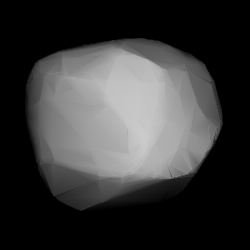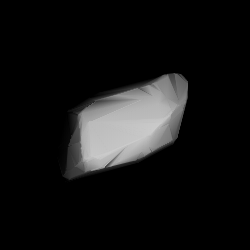
62 Erato is a carbonaceous Themistian asteroid from the outer region of the asteroid belt, approximately 95 kilometers in diameter. Photometric measurements during 2004–2005 showed a rotation period of 9.2213±0.0007 h with an amplitude of 0.116±0.005 in magnitude. It is orbiting the Sun with a period of 5.52 yr, a semimajor axis of 3.122 AU, and eccentricity of 0.178. The orbital plane is inclined by an angle of 2.22° to the plane of the ecliptic.

100 Hekate is a large main-belt asteroid.

120 Lachesis is a large main-belt asteroid. It was discovered by French astronomer Alphonse Borrelly on April 10, 1872, and independently by German-American astronomer Christian Heinrich Friedrich Peters on April 11, 1872, then named after Lachesis, one of the Moirai, or Fates, in Greek mythology. A Lachesean occultation of a star occurred in 1999 and was confirmed visually by five observers and once photoelectrically, with the chords yielding an estimated elliptical cross-section of 184 × 144 km.

128 Nemesis is a large 180 km main-belt asteroid, of carbonaceous composition. It rotates rather slowly, taking about 78 hours to complete one rotation. Nemesis is the largest member of the Nemesian asteroid family bearing its name. It was discovered by J. C. Watson on 25 November 1872, and named after Nemesis, the goddess of retribution in Greek mythology.

159 Aemilia is a large main-belt asteroid. Aemilia was discovered by the French brothers Paul Henry and Prosper Henry on January 26, 1876. The credit for this discovery was given to Paul. It is probably named after the Via Aemilia, a Roman road in Italy that runs from Piacenza to Rimini.

201 Penelope is a large main belt asteroid that was discovered by Austrian astronomer Johann Palisa on August 7, 1879, in Pola. The asteroid is named after Penelope, the wife of Odysseus in Homer's The Odyssey. It is orbiting the Sun at a distance of 2.68 AU with an eccentricity (ovalness) of 0.18 and a period of 4.381 years. The orbital plane is tilted at an angle of 5.8° to the plane of the ecliptic.

203 Pompeja is a fairly large main-belt asteroid. It was discovered by C. H. F. Peters on September 25, 1879, in Clinton, New York, and named after Pompeii, the Roman town destroyed in volcanic eruption in AD 79. This asteroid is orbiting the Sun at a distance of 2.74 AU with an eccentricity (ovalness) of 0.06 and a period of 4.53 yr. The orbital plane is tilted at an angle of 3.2° to the plane of the ecliptic.

214 Aschera is a Main belt asteroid. It was discovered by Austrian astronomer Johann Palisa on February 29, 1880, in Pola and was named after the Sidonian goddess Asherah. This minor planet is orbiting the Sun at a distance of 2.61 AU with a low eccentricity of 0.032 and an orbital period of 4.22 yr. The orbital plane is inclined at an angle of 3.44° to the plane of the ecliptic.

235 Carolina is a sizeable Main belt asteroid. It was discovered by Austrian astronomer Johann Palisa on 28 November 1883 in Vienna, and was named after Caroline Island, now part of Kiribati in the Pacific Ocean. This asteroid is orbiting the Sun at a distance of 2.88 AU with a period of 4.89 yr and an eccentricity (ovalness) of 0.06. The orbital plane is tilted at an angle of 9.0° to the plane of the ecliptic.

239 Adrastea is a main belt asteroid. It was discovered by Johann Palisa on 18 August 1884 in Vienna, and was named after the Greek nymph Adrasteia. This asteroid is orbiting the Sun at a distance of 2.97 AU with a period of 5.11 years and an eccentricity (ovalness) of 0.23. The orbital plane is tilted at an angle of 6.17° to the plane of the ecliptic.
255 Oppavia is a sizeable Main belt asteroid. It was discovered by Austrian astronomer Johann Palisa on 31 March 1886 in Vienna and was named after Opava, a town in the Czech Republic, then part of Austria-Hungary, where Palisa was born. It is orbiting the Sun at a distance of 2.75 AU with an orbital eccentricity (ovalness) of 0.077 and a period of 4.55 yr. The orbital plane is inclined by an angle of 9.47° to the plane of the ecliptic.

281 Lucretia is an asteroid belonging to the Flora family in the Main Belt. It was discovered by Austrian astronomer Johann Palisa on 31 October 1888 in Vienna, and is named after the middle name of Caroline Herschel, one of the first female astronomers. Light curves of this asteroid show a synodic rotation period of 4.349±0.001 h with an amplitude of 0.3–0.4 magnitude. The spin axis appears nearly perpendicular to the ecliptic.

299 Thora is a 17 km Main belt asteroid with a potentially long 274-hour rotation period. It was discovered by Johann Palisa on 6 October 1890 in Vienna.

341 California is an asteroid belonging to the Flora family in the Main Belt. It was discovered by Max Wolf on 25 September 1892 in Heidelberg, and is named for the U.S. state of California. This object is orbiting the Sun at a distance of 2.20 AU with a period of 3.26 yr and an eccentricity (ovalness) of 0.19. The orbital plane is inclined at an angle of 5.7° to the plane of the ecliptic.

348 May is a large Main belt asteroid. It was discovered by Auguste Charlois on 28 November 1892 in Nice, and was named for the German author Karl May. This asteroid is orbiting the Sun at a distance of 2.97 AU with a period of 5.12 years and an eccentricity (ovalness) of 0.067. The orbital plane is inclined at an angle of 9.7° to the plane of the ecliptic. During its orbit, this asteroid has made close approaches to the dwarf planet Ceres. For example, in September 1984 the two were separated by 6.3 Gm (0.042 AU).

352 Gisela is an asteroid belonging to the Flora family in the Main Belt that has an unusually high albedo.
412 Elisabetha is a large main belt asteroid that was discovered by German astronomer Max Wolf on 7 January 1896 in Heidelberg. It may have been named after his mother, Elise Wolf. This minor planet is orbiting at a distance of 2.76 AU from the Sun with a period of 4.59 years and an orbital eccentricity (ovalness) of 0.044. The orbital plane is inclined at an angle of 13.8° to the plane of the ecliptic.
538 Friederike is a minor planet orbiting in the asteroid belt. It is a member of the Hygiea family of asteroids.
630 Euphemia is a mid-sized Eunomian asteroid.
774 Armor is a minor planet orbiting in the main belt. It was discovered on 13 December 1913, in Paris by French astronomer Charles le Morvan and was named after the Celtic region of Armorica. The asteroid is orbiting at a distance of 3.05 AU with a period of 5.32 yr and an eccentricity of 0.169. The orbital plane is inclined by an angle of 5.56° to the plane of the ecliptic.















